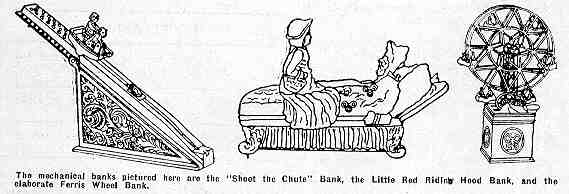The Old Toy Shop
By Louis H. Hertz — RELICS Magazine — March, 1946
MECHANICAL BANKS, Part 2
There exists such a wide range of designs in mechanical banks that it is difficult to cite "typical" banks unless space is available to devote to the description of several dozen basically different patterns. Of course, it is possible roughly to classify mechanical banks into a few general groups such as shooting banks, animal banks, house banks, bust banks, etc., but even within such groupings will be found an amazingly wide range of subjects and treatments, and this diversity is accentuated by the fact that various manufacturers, sometimes even different designers for the same maker, tended to treat the same subject differently at various stages of the mechanical bank era. Conversely, it is sometimes found that different manufacturers produced banks very similar in conception, or in physical design.

In the space available here, therefore, it is not possible to go into a very deep examination of the subject, and it appears more advisable simply to describe a few of the interesting bank types here, without attempting to evaluate them as to their specific relationship with the vast majority of banks which space does not permit us to touch upon. This will serve, however, to give some idea of the range of types made and some of the factors involved in their design and production.
Three of what might be termed "historical" banks are pictured, all of them basing their design on some incident in American history, the first two, the "Admiral Schley" or "Schley Bottling Up Cevera", as it is sometimes called, and the U. S. and Spain Bank dating from the Spanish-American War period.
The former is based on the "bottling up" of the Spanish fleet under Admiral Cevera by the United States forces under Admiral Schley. The scene was the harbor of Santiago, Cuba. The bank is made of cast iron, in the form of a bottle with a wide neck and an unusually large stopper. There is a round opening in the center of the stopper, disclosing a picture of Admiral Cevera. When a penny is inserted in the opening and dropped into the bank Admiral Cevera disappears and the portrait of Admiral Schley appears in its place.
In the U. S. and Spain bank, a cannon marked "U.S." fires a penny at the mast of a Spanish ship, knocking down the mast. This bank was made by the J. & E. Stevens Co. of Cromwell, Conn. Around 1898.
The third bank is the North Pole Bank and appeared shortly after the Pole was reached in 1909. At that time the controversy as to whether Commander Peary or Dr. Cook had actually been the first to reach the Pole was raging and the manufacturers (this is also a Stevens bank) omitted reference to either name on the bank itself and merely commemorated the event. When the coin is inserted the United States flag appears at the top of the bank.
The "Shoot the Chute" bank, another Stevens product, was made in the first decade of the present century, and is based on the most popular comic strip characters of that day, Buster Brown. Buster Brown and his famous dog, Tige, are portrayed in the boat which bravely "shoots the chute" depositing the coin as it does so.

Little Red Riding Hood is an early bank, dating from the 1880’s and is based on the familiar story, employing the characters of Little Red Riding Hood and her Grandmother, who turns out to be the wolf.
The Ferris Wheel Bank is one of the most elaborate of all and was made during the 1890’s. A mechanical toy, without the bank feature, but employing the same Ferris Wheel, clockwork motor, etc. but on a plain base, and omitting the box to hold the coins was also made by the same manufacturer.
Some of the banks pictured, the "Shoot the Chute", for instance, are comparatively elaborate. There were many mechanical banks manufactured whose mechanisms were simple in comparison, some, indeed, had so little action that they did not prove very successful sellers, especially if, for one reason or another, they did not appear upon the scene at exactly the right moment. Many of the most common banks, of course, are simple in operation, this simplicity often having merit in permitting a bank to be retailed at a lower figure, or in employing far sturdier construction than was possible with a complicated and delicate mechanism. Many of the single frog, owl, or rabbit mechanical banks are very simply made, and other banks such as the Tammany, Cabin, Excelsior, etc. are comparatively simple in construction and action. Among the most complicated banks, at the opposite extreme, are the Clown and Harlequin, the Freedman’s Bank, the Ferris Wheel, of course, and the Jumping Rope Bank. In between these groups, mechanical banks exist in all stages of comparative complexity. The most elaborate banks often sold for a higher price than the single dollar which was the common retail price for the average mechanical bank.
